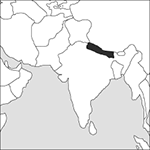
Source: MAPS IN MINUTES™ © RH Publications (1997)
Capital:
Kathmandu
Area:
147,181 sq km (56,827 sq miles)
Population:
30,430,267 (2013 est)
Currency:
1 Nepalese rupee = 100 paisa (or pice)
Religions:
Hindu 81.3%; Buddhist 9.0%; Muslim 4.4%
Ethnic Groups:
Chhettri 16.6%; Brahman-Hill 12.2%; Magar 7.1%; Tharu 6.6%; Tamang 5.8%; Newar 5.0%; over 100 minority groups
Languages:
Nepali (official); over 100 other languages
International Organizations:
UN; Colombo Plan; Non-Aligned Movement; WTO
A south Asian country among the peaks and southern slopes of the Himalayas, sandwiched between China (Tibet) and India.
Physical
Nepal contains the highest mountains in the world. The peaks are in the north; below the snow-line rivers run through turfy valleys and fine forests.
Economy
Much of the land is not cultivable and deforestation is a major problem. However, the economy is primarily agrarian, with principal crops of pulses, rice, cereals, sugar cane, and jute. Industry is limited mainly to agricultural processing. Tourism is a major source of revenue and remittances from expatriates are important.
History
Nepal’s first era of centralized control was under the Licchavi dynasty, from about the 4th to the 10th centuries. During this period Buddhist influences were dominant, but under the Malla dynasty (10th–18th centuries) Hinduism was the dominant religion. In 1769 a successful Gurkha invasion brought to power the present ruling dynasty. From their capital at Kathmandu they wielded absolute power over the indigenous Nepalese tribes. Their incursion into north-west India led to a border war (1814–16) and to territorial concessions to the British (Treaty of Kathmandu, 1816). Effective rule then passed to a family of hereditary Prime Ministers, the Ranas, who cooperated closely with the British. Gurkhas were recruited to service in the British and Indian armies. Growing internal dissatisfaction led in 1950 to a coup, which reaffirmed royal powers under the king, Tribhuvan (1951–55). His successor, King Mahendra (1955–72), experimented with a more democratic form of government. This was replaced once more with monarchic rule (1960), which continued under his son, King Birendra Bir Bikram (1972–2001). Following pro-democracy demonstrations and mass arrests from 1989 onwards, the king agreed to legalize political parties, and granted a new constitution in November 1990, establishing a bicameral parliament; the first democratic election was held in May 1991. In 2001 the King and most of the royal family were murdered by the Crown Prince, Dipendra, who then committed suicide. Gyanendra, the late King’s brother, took the throne. A Maoist guerrilla insurgency flared up in 2002, and in 2005 the King declared a state of emergency and assumed personal control of the government. However, popular protests forced him to restore parliamentary rule in 2006. Later that year he was stripped of his remaining powers and a ceasefire was agreed with the rebels. Negotiations for a final settlement and a new constitution soon became deadlocked, and a series of short-lived governments achieved little.
In 2007 the Maoists signed a ceasefire and joined the government and in 2008 decisively won elections for a constituent assembly. This assembly promptly abolished the 239-year-old monarchy and declared a republic. Ram Baran Yadav, formerly of the Nepal Congress Party (NCP), became Nepal’s first President. He was replaced in October 2015 by Bidhya Devi Bhandari. The Maoists formed an interim administration but withdrew in 2009. Since then the situation has been fairly chaotic. The constituent assembly failed to produce a constitution and was dissolved in 2012, and Baburam Bhattari of the Unified Communist Party of Nepal (Maoist) led a caretaker government as Prime Minister, until March 2013, when he was replaced by Kil Raj Regmi. Elections were held in November 2013, in which the NCP gained most seats and the Maoists came third. In February 2014 Sushil Koirala (1939–2016), the leader of the NCP, was elected Prime Minister by the constituent assembly. He was succeeded by Khadga Prasad Oli in October 2015 and then by the Maoist leader Pushpa Kamal Dahal (Prachanda) in the following year.
In April 2015 the country was hit by a severe earthquake and many aftershocks. Over 8,500 people died, 17,000 were injured, and 3 million were displaced from their homes. Historic buildings, temples, hospitals, and much of the county’s infrastructure were damaged and agriculture disrupted. The government has estimated the value of the damage at $19 billion and it will take years for the country to recover. Progress has been slow, not least because of the chaotic nature of government since the earthquake.
- kalinite
- kaliophilite
- kallidin
- Kalman filter
- Kalman, Rudolf Emil (1930)
- Kalmar, Union of (1397)
- Kalpana-1
- kalsilite
- Kaluza, Theodor Franz Eduard
- Kaluza–Klein theory
- Kama
- Kamakura shogunate
- Kamarkar’s method
- Kamchatka current
- kame
- kame delta
- Kamenev, Lev Borisovich (1883–1936)
- kamenitza
- Kamerlingh-Onnes, Heike
- kame terrace
- kamikaze
- kamikaze grains
- kamikaze packet
- Kamiokande
- Kammerer, Paul